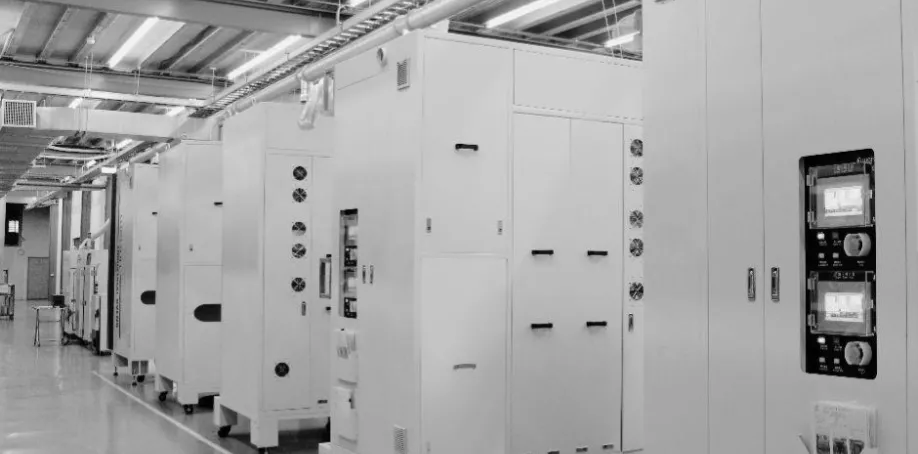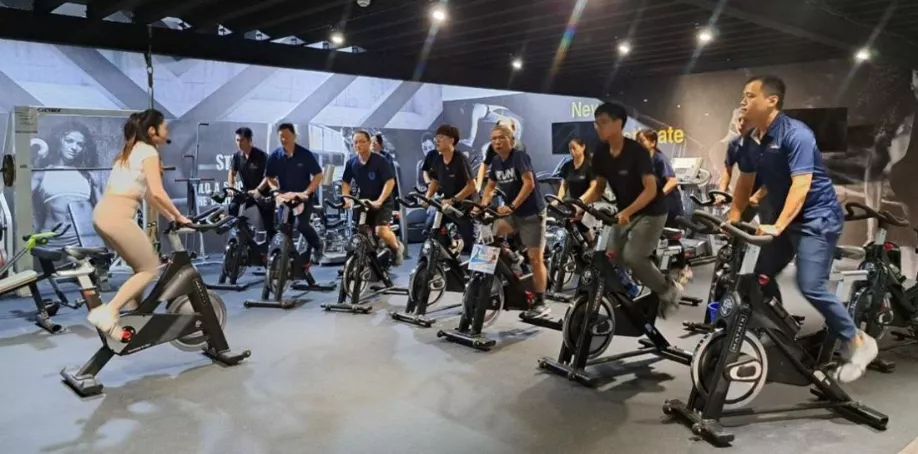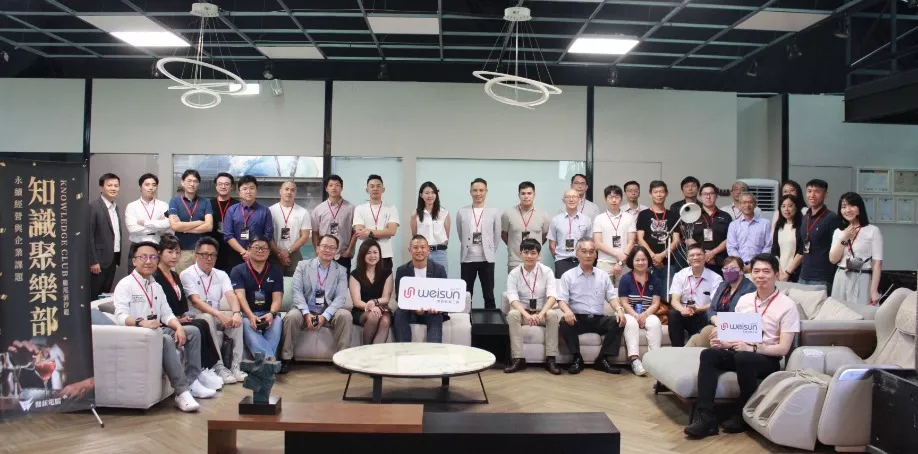We extend our heartfelt thanks to the Digiwin Knowledge Club for leading industry leaders to visit WEISUN. We were delighted to share our success stories in driving digital transformation through corporate culture with esteemed guests from various major enterprises. We look forward to exploring more possibilities for digital transformation across industries together, embracing new challenges and opportunities hand in hand. Below is the complete report from the Digiwin Knowledge Club:
In 1976, Hesheng Instruments was founded. In 2022, it was officially renamed WEISUN INDUSTRIAL CO., LTD. This seemingly simple change in name encapsulates a 14-year journey of transformation. This journey showcases the arduous shift from traditional OEM to a technical brand, illustrating the successful transition of the second generation, who introduced digital tools and reshaped corporate culture, overcoming the low-profit margin dilemma. The Digiwin "Knowledge Club" invited corporate managers to visit WEISUN INDUSTRIAL CO., LTD. for the first time, offering an on-site understanding of this remarkable transformation journey.
Low-Value Fate of Traditional OEM Factories Stuck at a 3-4% Profit Margin
Summer and winter breaks are my worst childhood memories. While my classmates were playing, I had to help out in the factory all day, surrounded by high temperatures, intense heat, and metal scraps everywhere," recalls WEISUN General Manager Max Chen about the past. In the 1970s Taiwan, most small and medium-sized manufacturing enterprises started as OEMs. At that time, WEISUN took on OEM work for large domestic drying companies. The spirit of the company's leadership was much like traditional old Taiwan – hard-working, practical, and fiercely competitive.
To secure orders left over from the large companies, working through the night and pushing for early deadlines were routine. Feeling for his elders, Max Chen decided to join the family business after graduation. He trained from the ground up, mastering sheet metal work, welding, assembly, and design from scratch. However, the financial crisis hit mercilessly.
At that time, I felt a strong sense of helplessness. You watch veteran employees dedicate their lives, yet you can't take care of them because traditional small and medium-sized enterprises are always just thinking about survival," he said. The barriers to entry for traditional drying technology were not high, competition was fierce, and the output value and profit margins were low. As an OEM factory, it was challenging to improve its position in the industry value chain, and it couldn't accumulate technology and reputation. This intense dissatisfaction drove Max Chen to push for transformation. In 2009, WEISUN established its own brand to carve out a path beyond OEM.

General Manager Details WEISUN's Step-by-Step Transformation from Traditional OEM Photo: General Manager Max Chen
R&D and Marketing Shape the Brand, Breaking Free from the OEM Fate
However, the path to transformation is neither easy nor straightforward.
WEISUN established a design and R&D department, gradually developing new products. Under the old OEM model, technical expertise was concentrated among veteran craftsmen who were resistant to change. Convincing them to pass on their knowledge and fully share their skills was a significant challenge. Max Chen found a workaround by finalizing the design and specifications of the ovens externally and only bringing them in for welding, solving the problem of technical isolation and knowledge gaps.
However, building talent, technology, and direction remains crucial. "I handle business myself, actively talking to customers to persuade them while understanding the external market demands." Despite the advantage of being the second-generation boss, he rolls up his sleeves to practice his skills and takes flyers to expand his customer base and familiarize himself with the market.
This exploration phase took five years. WEISUN continued to invest in R&D and marketing, accumulating professional know-how and gradually establishing brand trust. They actively participated in semiconductor, TPCA, and panel exhibitions to promote their brand. Salespeople engaged with customers to understand market demands, while marketing efforts increased brand visibility. Transitioning from working behind the scenes as an OEM, they moved to the forefront, directly communicating with the market and providing services to customers.
Building a brand is like constructing a skyscraper; the foundation, though unseen, becomes critically important over time. By 2014, WEISUN had reduced its OEM ratio to below 50%.
"Many manufacturing companies in Taiwan have excellent technology but lack exposure. Since establishing our brand, WEISUN has placed a high emphasis on marketing. Even though we didn’t see immediate results and revenue didn’t improve right away, I insisted on continuing," Max Chen shared his insights. "Constant accumulation pays off over time."

Photo: Manufacturing Site of WEISUN.
Without transformation, WEISUN might have disappeared long ago
Transformation requires patience and continuous upgrading—digital transformation and organizational reshaping are the paths to WEISUN's evolution.
In 2017, WEISUN's ovens transitioned from manual to automated, with specifications meeting semiconductor processing standards. Today, the equipment has further advanced towards intelligence.
Visiting the factory where WEISUN collaborates with Digiwin, they have introduced a smart logistics system to effectively manage material preparation and inventory storage. In the past, the baking and drying processes relied heavily on manual judgment of temperature and humidity. WEISUN has gradually shifted to digital systems that integrate temperature, pressure, flow, dust-free, and oxygen-free environment controls. These systems, learning through data computation, can automatically predict equipment failures and schedule maintenance. This not only enhances production efficiency but also automates loading and unloading operations at the client end, reducing labor costs with AGV unmanned vehicles.
In recent years, with the trend towards low carbon, WEISUN has further implemented digital meters to monitor carbon emissions and adopted heat recovery technology. These adjustments meet the ESG requirements of the semiconductor supply chain and demonstrate their proactive attitude towards sustainable operations.
"In the past, it was about price; now it's about value," Max Chen stated bluntly. "Without digital transformation, WEISUN might have disappeared!"
The Core of Transformation is People
However, the process of digital implementation faced significant challenges.
Beyond R&D and production, as business scale grew, the old paper records made it difficult to integrate order information in real-time. Thus, WEISUN adopted the Dingxin ERP system as the foundational architecture to digitize across departments. Initially, it was a disastrous failure.
System integration wasn't the issue; the problem lay with the people. Max Chen admitted, "Employees didn't understand why they had to go through so much trouble and re-adapt, and they were resistant."
WEISUN didn't give up because advancing the brand to high-end specifications requires the integration of order, production, marketing, and inventory information. Providing real-time information and data reports for decision-making is a necessary path for industry upgrading.
After reviewing, they collaborated with Digiwin again, prioritizing thorough communication. Just as communication is essential with clients, internal transformation requires dialogue with all employees, clearly outlining the purpose and value of each action. More importantly, the digitalization setback reminded WEISUN of the importance of unifying company values—a common bottleneck in traditional business succession and transformation. Facing employees from different generations and cultural backgrounds, how should shared beliefs and values be created?
The surprising solution WEISUN used to rebuild consensus was sports!

From the initial "mosquito room" to daily fitness classes, sports have become the best language for connecting people at WEISUN. Photo: WEISUN Gym
Transformation Involves Many Tasks, but the Core Always Comes Down to People
Max Chen, who has always had a passion for sports, created a gym within the company. Mountaineering, badminton, and long-distance running clubs, regular internal competitions, and team registrations for events—employees who once watched from the sidelines now eagerly sign up for sports classes the moment they open.
Max Chen, who has always had a passion for sports, created a gym within the company. Mountaineering, badminton, and long-distance running clubs, regular internal competitions, and team registrations for events—employees who once watched from the sidelines now eagerly sign up for sports classes the moment they open.
From being dissatisfied with mere survival to striving to make drying technology the best in the industry, Max Chen has given employees a common goal to strive towards. Reflecting on the transformation journey from dried fruit to semiconductor wafers, Max Chen said, "Transformation involves many tasks, but the core always comes down to people."

The Knowledge Club’s First Visit to WEISUN
During the Knowledge Club’s inaugural visit to WEISUN, participants not only learned about WEISUN’s transformation strategies but also toured the drying factory, laboratory, and the innovative office spaces that break away from traditional designs.
Source:digiknow


